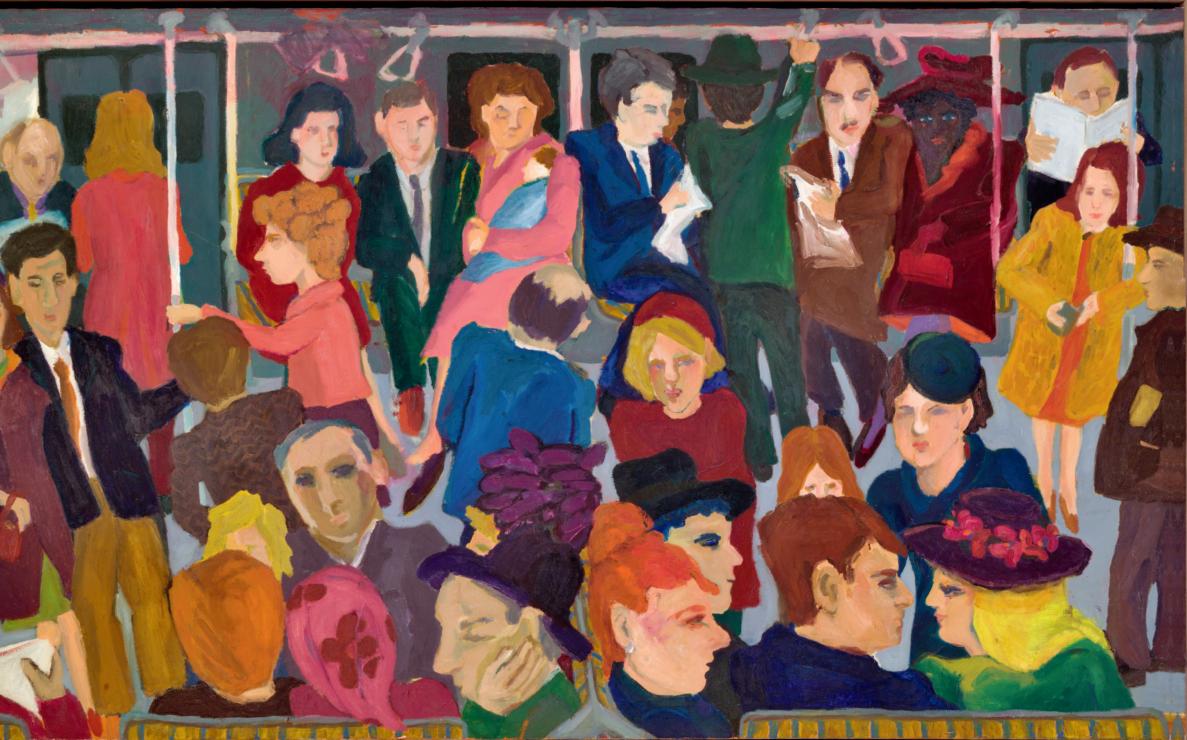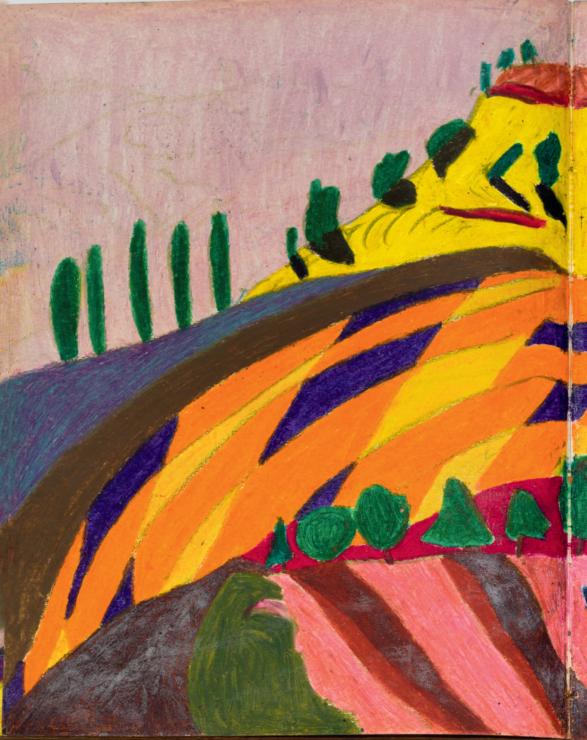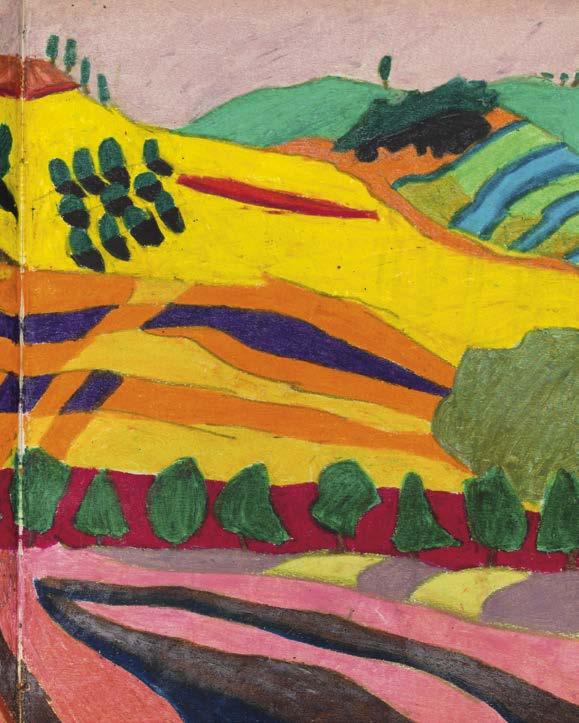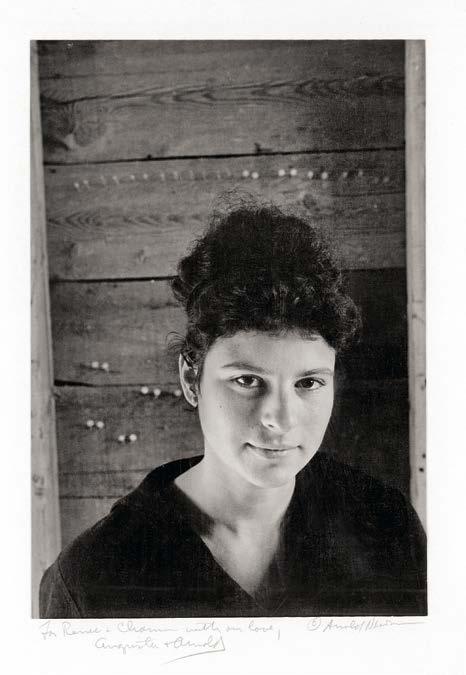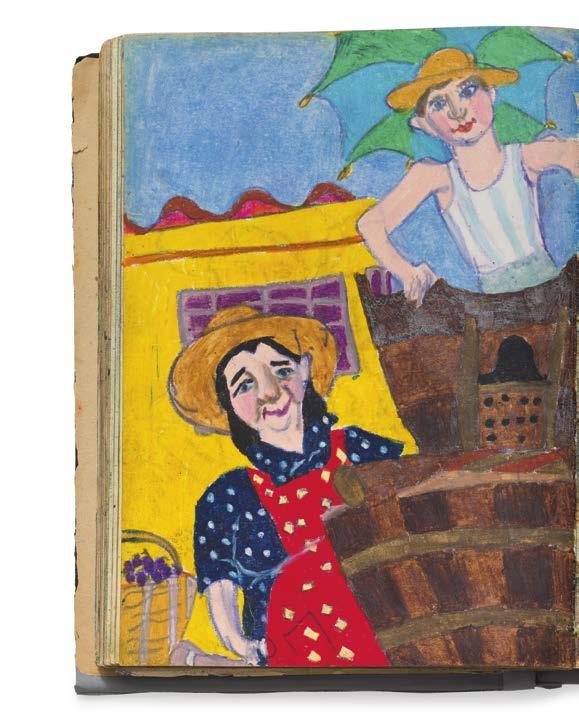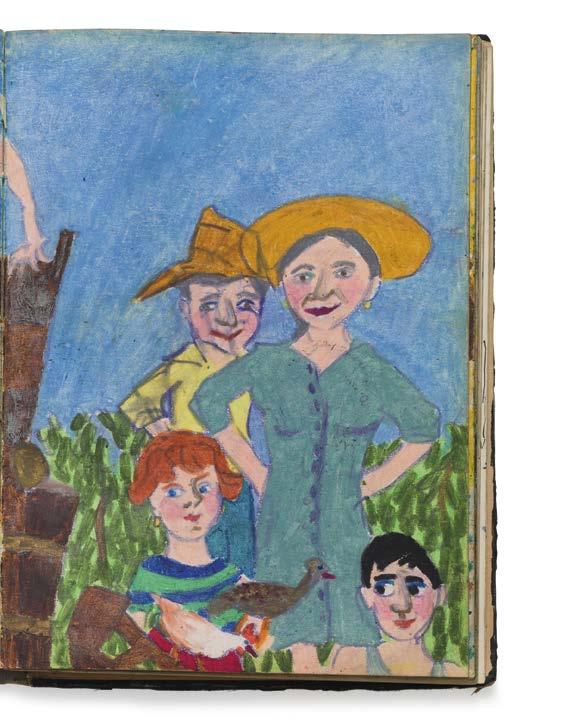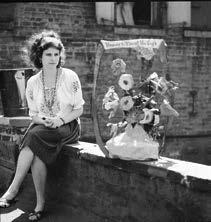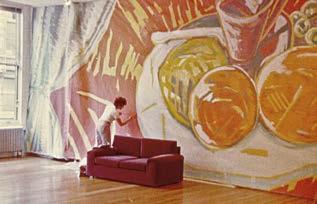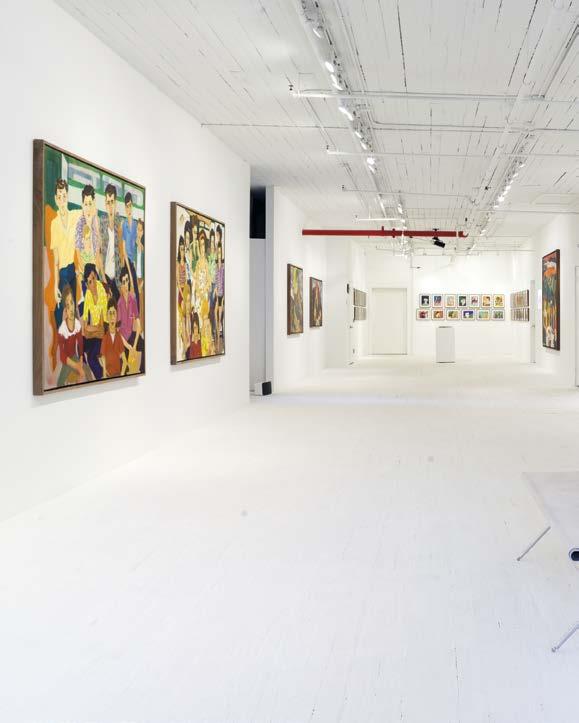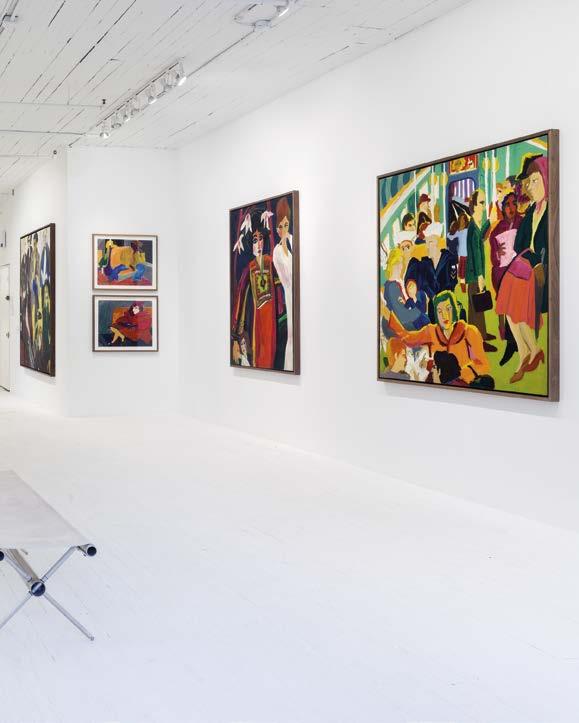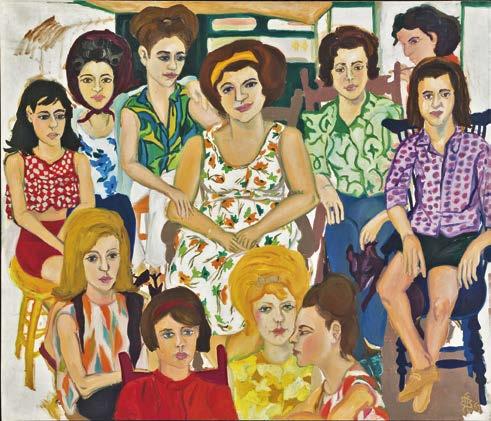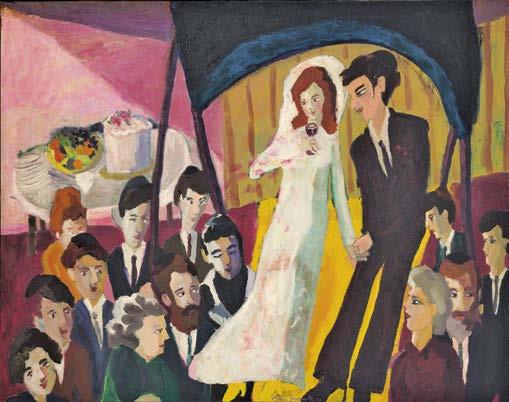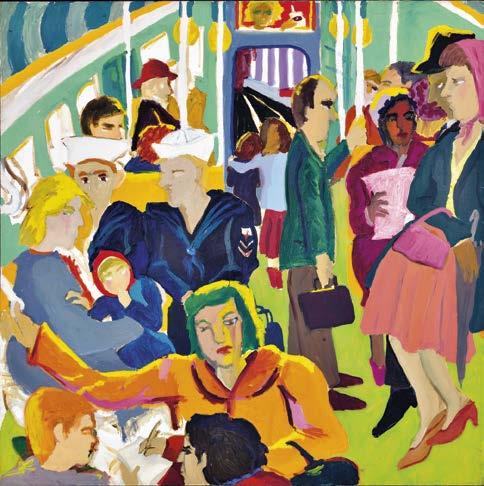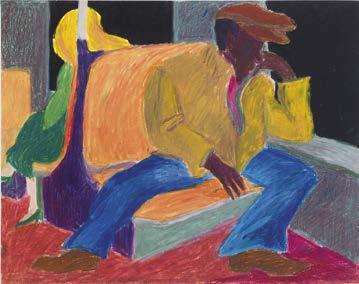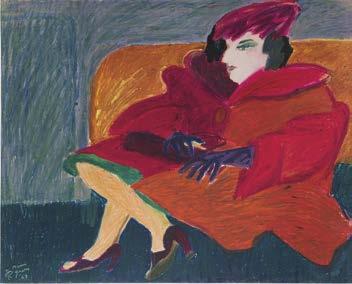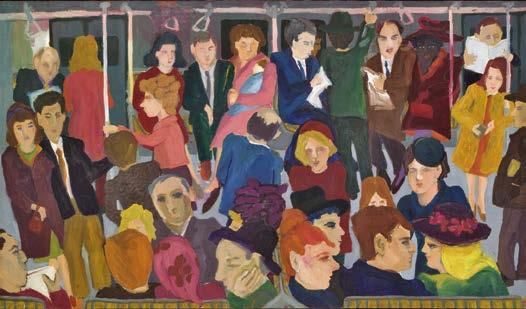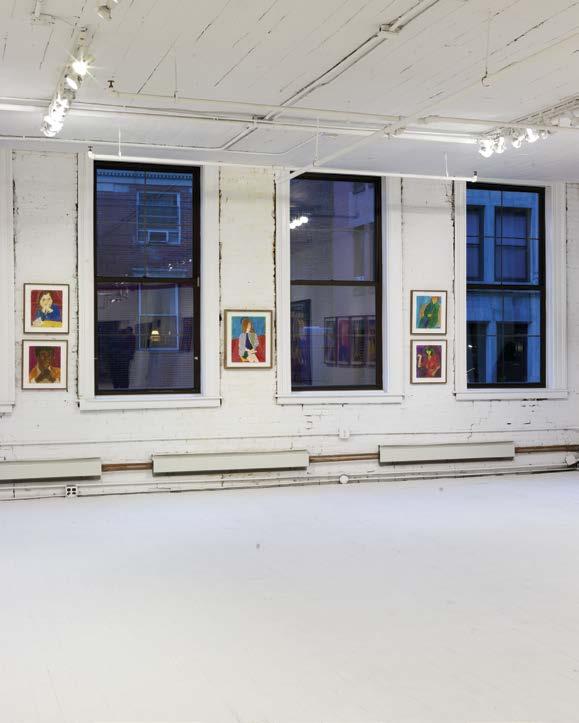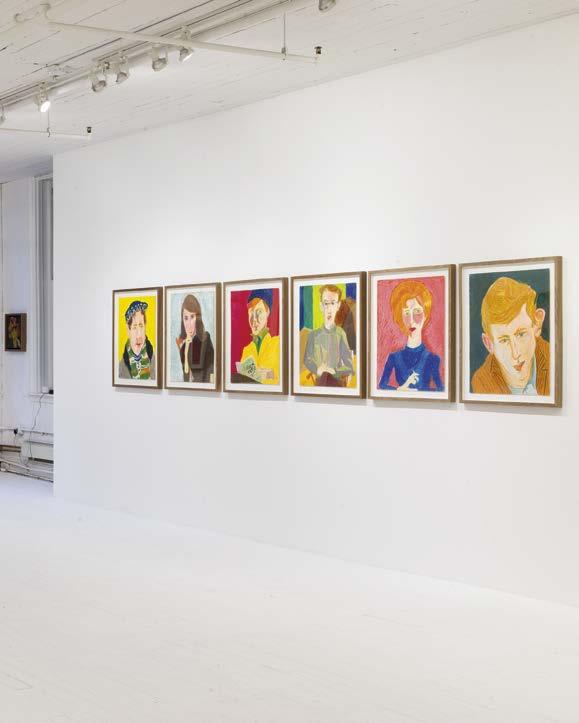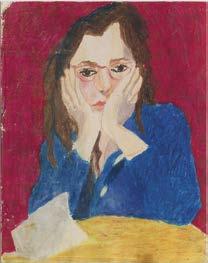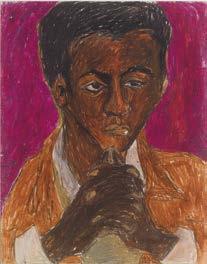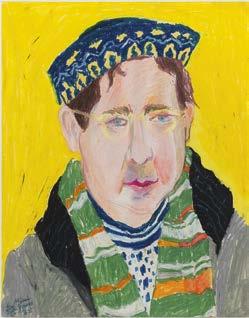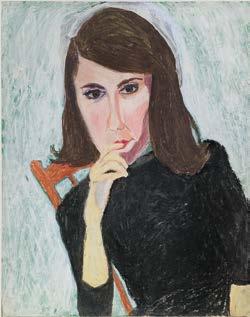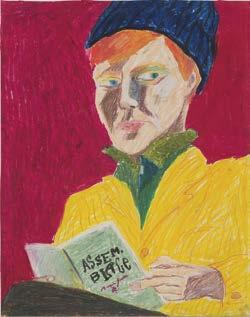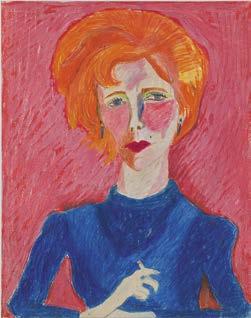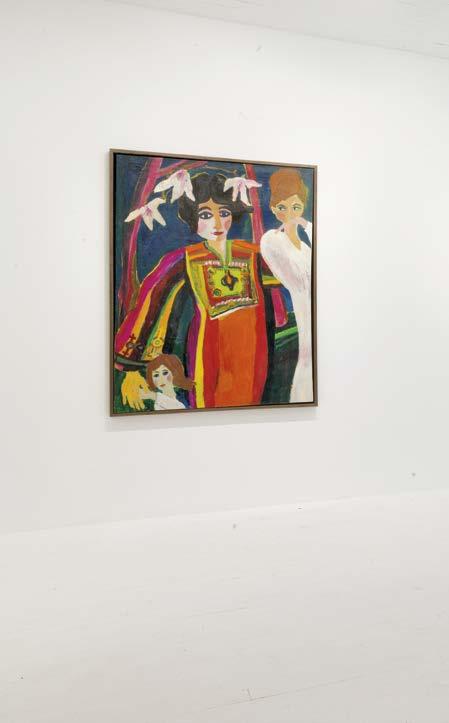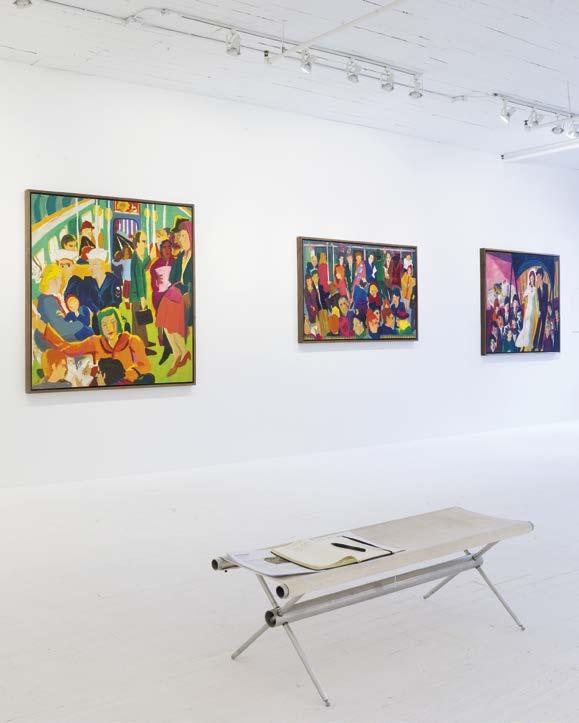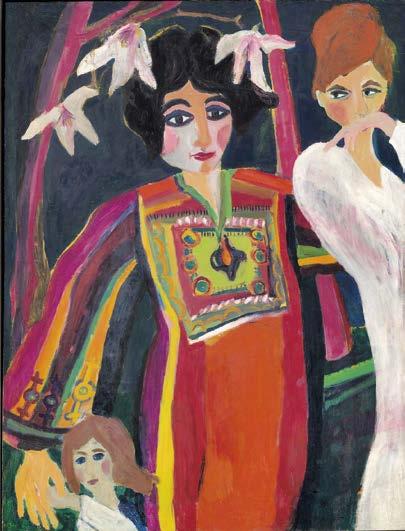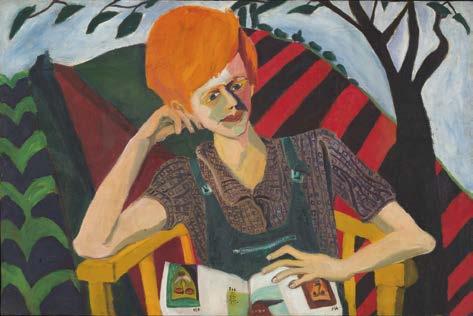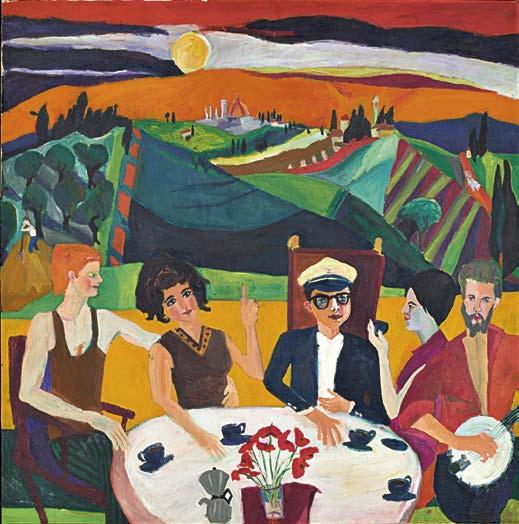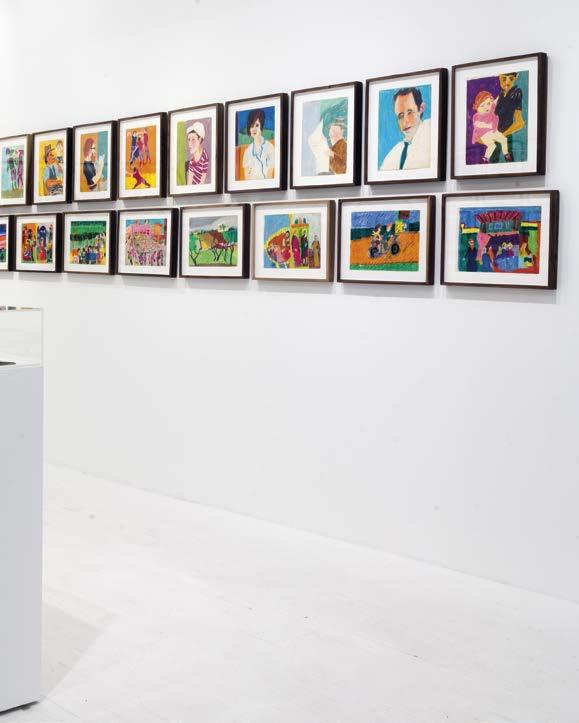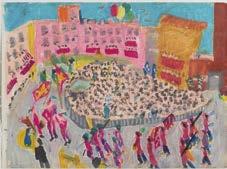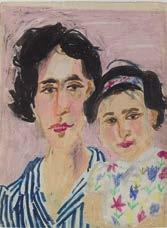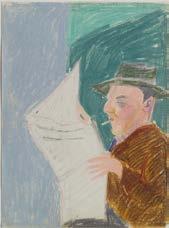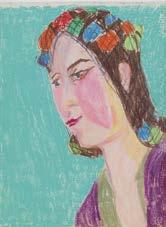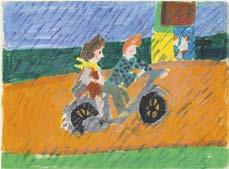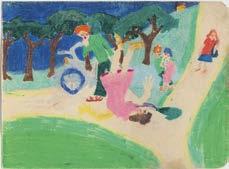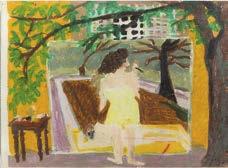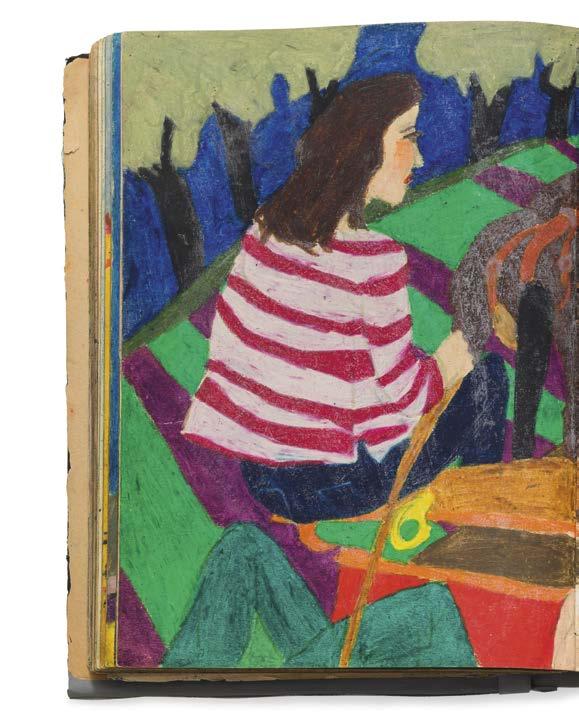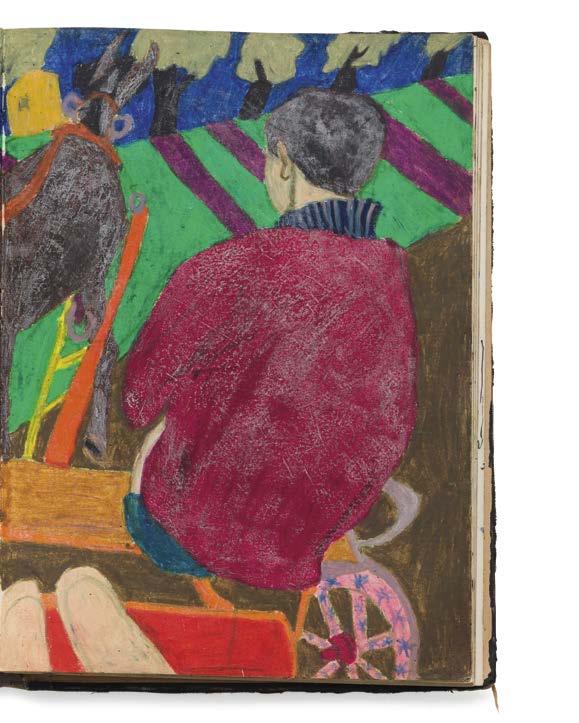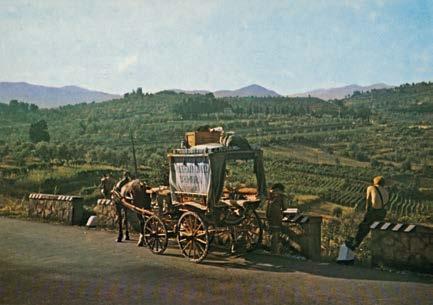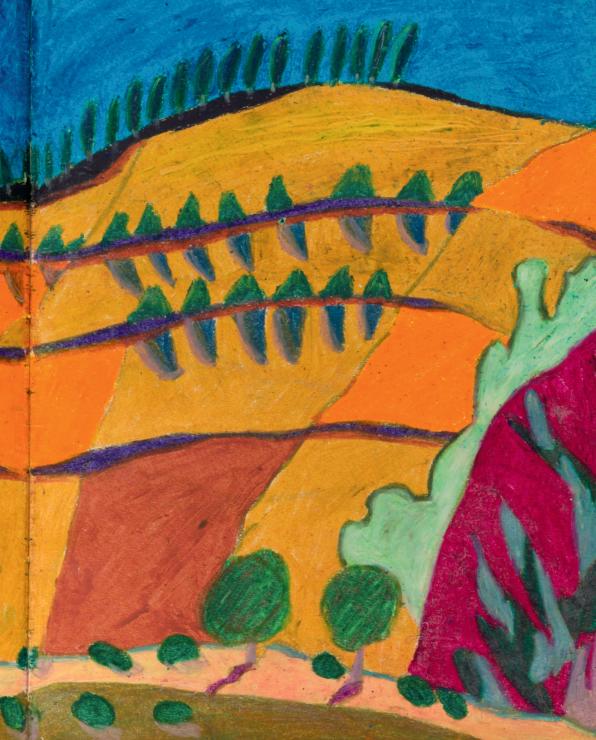Among Friends
by Mira Schor
expression—the artist has gained confidence and the subjects themselves are more mature and intensely involved in their own creative work. In the portrait of artist and illustrator Cabell Brussel, the subject wears a beautifully patterned hat and scarf in tones of olive green against a yellow ground that is picked up in his yellow eye glass frames. An almost cubistic play of shadows emphasizes the angularity of artist Red Groom’s face, as, in a dark blue beret, olive green scarf, and yellow shirt, he reads a book on Assemblage against a dark red background which contrasts with his hair, painted a rich dark earthy orange. If you talk to Gross about these works, each portrait is a short story—a clean cut young man, “burned all those buildings down.” Why? “He was an arsonist!” But “he made the most beautiful art works, architectural models based on Italian paintings.” 1 This anecdote is characteristic of Gross’s joyful appreciation of the complexity of human character.
Gross’s engagement with portraiture is democratic and humanist in nature. She has a tremendous appreciation for the individuality of all the people she meets and sees. As she says, she’s “not interested in judgement . . . the psychology is natural,” stemming for her infinite curiosity about people. Drawing people is an intimate connection—and Gross wraps each subject in an atmosphere of respect and the privacy of their own thoughts. This is as true for large canvases depicting groups of people as it is for the individual portraits. Each person is alone yet also together in multiple-figure large oil paintings such Grand Street Boys and Grand Street Girls from 1963 which depict
teenagers from the Italian neighborhood around Grand, Thompson, and Sullivan streets, now part of Soho where Gross had her studio in the early 60s. Very few look directly at her, that is to say, at us, the viewer; they look to the side, as people do when they are at rest or thinking.
Two subway scenes also give a pulsating sense of city life, each person alone in a crowd but completely themselves. Subway (1962) is an unfinished work— unfinished from the point of view of the artist though to a contemporary eye its rough edges add to the vibrancy. At the bottom of the work is a self-portrait of Gross sketching—like most of Gross’s large paintings, this is a studio painting based on sketches made from life. That little area of “unfinished” white space where her hand holds a pen is a wonderful vignette of creativity: the painting springs from the unfinished page of the sketchbook.
In many of these works there is no chromatically neutral zone, the entire field of the painting or oil crayon drawing is richly pigmented. The effect of Gross’s use of brilliant hues, from earth tones to rich reds and yellows, to bright pinks combined with a dynamic use of black as well as brightly colored
outline is a tremendous sign of artistic confidence, which in the work of an artist age 17 or 18 or even 23 is astounding. Such painterly assurance at an early age is one component of the happiness factor contained in the work. Doubt is not part of the package. Gross was driven in her process and she was freshly engaged in the world and with the art she knew.
The natural quality of Gross’s approach to painting and figuration nevertheless is rooted in many histories of art—the historical art she saw, and the contemporary art worlds she was born into and lived through.
Ernst Kirchner was one of her favorites and one perceives his influence in Gross’s use of bright hues and in the way figures in a crowd sit on the canvas surface. A major exhibition of “German Art of the Twentieth Century” at MoMA in 1957 had an enormous impact on her. She loved Soutine and also Rajput Painting and Matisse. She had visited the Barnes Collection before going to Europe in 1959. By age 18, her courage as an artist, her form, love of line and color were fully fledged.
A few of Gross’s works from this period were included in New York University’s Grey Art Gallery 2017 exhibition, Inventing Downtown: Artist-run Galleries in New York City, 1952–1965 . Included was an oil crayon sketch from 1958, from the same trove of oil crayons in “Mimi Gross: Among Friends,” representing figures dressed in red, blue and yellow, surrounded by the entire swirl of energy of the New York street sketched loosely and confidently—a work marking Gross’s involvement in City Gallery, a short lived artist-run exhibition space founded by Jay Milder and Red Grooms.
Among the artists included in Inventing Downtown were a number of painters interested in reintroducing
Mimi Gross outside terrace space, west Grand Street studio, 1963

figuration into painting while retaining the painterly freedom associated with what had been the dominant art form of the 1950s, abstraction, whether expressionist or minimalist. They adapted the painterly brushwork of expressionism to a more contemporary, casual approach to New York City life and subcultures. As young artists working today turn away from the reprise of abstraction termed “zombie formalism” to all manner of figuration in painting, there is renewed significance to revisiting the figurative painters working in the late 50s and early 60s, among these Alex Katz, Jane Wilson, Robert Beauchamp, Jan Muller, Gandy Brodie, Bob Thompson, Yvonne Andersen, Marcia Marcus. Other artists working in a similar vein or who also melded representation with painterly abstraction included artists such as Alice Neel and Fairfield Porter as well as David Park in San Francisco. “Among Friends” highlights Gross’s rightful place at the forefront of this important movement of American post-War art.
Gross grew up at a moment when the center of art had shifted from Paris to New York, where an epic
battle took place over how art should respond to the horrors of the Second World War and at the same time to the consolidation of American capitalism. To be a representational artist or an abstract one was to enter as pitched a battle as between the Huguenots and the Catholics in Sixteenth-century France. The period was so fruitful artistically in part because it emerged initially from a fairly small group of people with many interconnections going back to the even smaller New York art scene of the 1920s and 30s, with many having participated in the WPA.
This rich artistic atmosphere was Gross’s birthright, as the daughter of noted sculptor Chaim Gross. Chaim and his wife Renée collected art including the art of their time and also built an impressive collection of African Art. They entertained frequently, assembling a wide circle of artists and luminaries from politics, theater, and film. A treat of visiting the Gross’s final home in New York City, now the Chaim and Renée Gross Foundation, is viewing a floor-to-ceiling installation of pictures from their parties which included guests such as Marilyn Monroe and Anthony Quinn, who took sculpture lessons with Chaim and purchased one of Mimi’s early paintings. Lifelong influences included family friend Raphael Soyer who was very supportive of Gross as an artist in her own right. Thus, she grew up surrounded by serious artists, brilliant people, and characters. Art world socializing in bars like The Cedar is well-known, but there was also a vibrant social life in artists’ homes and studios, expanding to include performances, happenings, and film showings. It was a rich and generative artistic environment at every level.
The work in “Among Friends” emerges from a special type of moment that occasionally occurs in
Mimi Gross painting outdoors on the roof at Bagno a Ripoli (Firenze), 1961


the history of art, when a constellation of creative friendships among visual artists, writers, musicians, and dancers, often in their youth, at a point in their lives when they are still relatively carefree and sometimes also in love, coalesce into an explosion of cross-disciplinary artistic work, individual and collaborative, that later becomes the subject of legend. These moments take place outside of the frame of the art market, before each individual’s path is fixed and their fate is determined. Such moments are impossible to sustain, but it can be conclusively proven that these are often the happiest times in the lives of these artists and often too those artworks that later are seen to have the greatest market value emerge from just these moments of friendships and creative projects undertaken in relative conditions of anonymity, for the sheer joy of making and the pleasure in shared ideas. We can look to the short moment of Diaghilev’s Ballet Russes in Paris before World War I, or the now legend-
ary summers at Black Mountain College and the early days of the Club in New York. Every person in such circles contributes to its vitality, though art history tends to make these moments act as background for the individual genius narrative.
One such moment is the source for some of the most notable works in “Among Friends.” In 1959 Gross and her college friend Katharine Kean, known as KK, met up in Europe and traveled to Florence. They painted and drew, studied art at the Uffizi, and made friends with other young Americans. In the summer of 1960 Mimi briefly studied with Oskar Kokoschka in Salzburg, where, she recalls, Kokoschka criticized her sloppy New York style and never accorded her his daily mark of approval—a candy and an “OK”! Red Grooms joined her in Florence and in the summer of 1961, a small group including Gross, KK, KK’s Florentine boyfriend Nello Falteri, known as Paperino, Grooms, and blue grass musician Pete Stanley, set
Roo Dane, Mimi Gross, and Katharine Kean, with the horse-drawn cart at Bagno a Ripoli, 1961
Mimi Gross in costume. She made the poster behind her to advertise the Adami Family Circus encountered during the 1961 trip.

out on an artistic adventure to fulfill Gross’s idea of traveling by horse and cart through the small villages of Northern Italy while giving shadow puppet performances at night in small village squares—a tribute to Fellini’s La Strada. Preparations were made, a horse was found and leased for the trip, a cart was purchased and painted with vignettes of the life of St. Usignolo, an invented saint of circus performers. Gross painted the cart herself using enamel paints— every night Grooms had to wash her down with turpentine. Stanley painted the name of the travelling theater on roll-up curtains on both sides of the cart: “Il Piccolo Circo d’Ombra di Firenze”—“The Little Shadow Circus of Florence.” They traveled for seven weeks during July and August following a route from Florence North East through Parma, Verona, Padua, and small hill towns on the way to Venice and back down to Florence along the Adriatic Coast passing through Ravenna.
This mythic midsummer trip is memorialized in three remarkable sketchbooks containing a glorious daily record of what they saw on their trip, often drawn from the vantage point of the cart as it moved slowly along: the pages are filled with drawings, some ink line drawings, many fully developed oil crayon works, depicting the people, landscape, and magnificent art and architecture encountered during the trip, magnificent Romanesque and brightly patterned Gothic churches, church paintings and sculptures, at the same time as circus performers, geese on a town green, far-off hills layered with different colors, and the contemporary cast of characters encountered in bars and cafes along the route. Occasionally one page of the spread is haunted by the imprint of the crayon drawing on the other page, a kind of pentimento of her line, color, and process.
Raphael Soyer visited Gross at her studio in Florence and reported that “On the wall hung her
Red Grooms, Mimi Gross, and Pete Stanley (playing the banjo), with the horse-drawn cart
exuberant, completely uninhibited paintings.” 2 Perhaps he saw Gross’ bold self-portrait The Arab Dress, an almost impossibly effulgent vision of the young artist, with huge bright eyes outlined in black line, crowned by flowers, wearing a dress whose embroidered red and orange front stands out from the dark ground. Gross saw an exhibition of Hans Hofmann at the Venice Biennale while she was in Italy and she was very impressed by Hofmann’s characteristic articulation of floating rectangles of bold color.
Via Guelfa Visitors (Firenze) is an impressive large group portrait, unusual in its relatively subdued color scheme, a whited-out ground, darks and blacks of the winter coats people are wearing indoors, each person’s elegance and eccentricity delineated from head to toe with the painting framed on one side by the elongated body of a woman whose head is cut off at the top of the painting as are her black stockinged feet at the bottom. Each figure is nestled into the eccentric outlines of the person next to her and at the center is a more richly painted, more colorful character, dark skinned, an expressive face with darkly outlined eyes, holding a cigarette in a holder, a very elegant European!
Gross also painted two exceptional and complex portraits of the two people dearest to her at the time:
Katharine Under the Persimmon Tree and Tuscan Afternoon, a portrait of Red Grooms, both from 1961. KK is a very still and thoughtful figure, her features very delicately limned, framed and encompassed by the differently scaled patterns of the persimmon tree on a white ground, a darkly colored patchwork quilt, and a delicately embroidered shirt. There is an exquisite balance of painterliness and painterly detail accomplished with a light hand and precision, recalling the way Velázquez establishes a pattern with precision yet loosely abstract markmaking.
The portrait of Grooms has a different pictorial feeling, bolder yet more sober in composition and scale. Grooms’ figure bisects a patterned hill rising up behind him, red and black striped fields pointing our eye in towards the figure to the right of the composition, dark green and deep red fields and road leading our eye back to the left. In the center Grooms’ big dome of orange hair nearly dwarfs his delicately painted, thoughtful features, mirrored in the reproduction of a folk-art mask in the book he holds on his lap in the foreground.
Bagno a Ripoli (Firenze) (1961) is the deliriously joyful summation of this work done in that mythic summer: it is a dense, very colorful, richly patterned
Mimi Gross (left) and helper building the set designed by Mimi for Douglas Dunn’s dance, Sky Eye, Attorney Street studio, 1989
composition that expands similar scenes from the sketchbook to a large square canvas, depicting four happy figures relaxing at a table, set like a Nabis still life, little black espresso cups and coffeepot on a white table cloth, set off by a simple bouquet of red flowers in the immediate foreground. Gross herself points her finger to the extraordinary early evening landscape behind them, a ziggurat of color with the Baptistry of Florence in the distance, a dream vision set against horizontal bands of orange, black, white, and red, reflecting the setting sun.
Gross has continued her engagement with portraiture, including major multifigure portraits such as Arlene Raven’s Ladies Art Group (2011) and the recent Genny’s Anatomy Class/ after Dr. Nicolaes Tulp’s Anatomy Lesson (2016), whose composition is based on Rembrandt’s painting from 1632, in Gross’s version with an all-female class of anatomy students and teacher. She has also worked on major public commissions including a characteristically brightly hued playground in Robert Venable Park in Brooklyn. Her sketchbooks have grown into a consistent practice, recording her travels in China, Japan, Haiti, India, and Mexico . Some of These Daze is a moving collaboration with poet Charles Bernstein, with selections from
Gross’s five notebooks of drawings made at Ground Zero in the days after 9/11.
Gross’s long-term work as costume and set designer with Douglas Dunn Dance Company has allowed her to pursue her interest in the human body—for the past forty years Gross has been a student of anatomy, of Craniosacral therapy, and of the Alexander Technique. In her costume designs for the dance, she has developed her love of color into an encyclopedic interest in the chemical properties of pigments and dyes, to produce bird of paradise-like colored costumes for the dancers. The set designs have afforded Gross an architectural scale for colorful set design. She is able to work directly with the human body in movement and with color in a kinetic, dynamic manner at a large scale.
The work continues, and, as always, among friends.
Notes
1 Quotes are from a conversation between Mimi Gross and Mira Schor held at Eric Firestone Gallery, March 20, 2019.
2 Raphael Soyer, quoted in Liza Kirwin, “Il Piccolo Circo d’Ombra di Firenze: Travels in Northern Italy with Mimi Gross, Red Grooms, Katharine Kean, Nello Falteri, and Pete Stanley,” Archives of American Art Journal 52: 1–2, 9.
Mimi Gross painting the set for the studio performance of Douglas Dunn’s Secret of the Waterfall , 1983.
Photo by Grazia Della Terza
All installation images are views of the exhibition Mimi Gross: Among Friends, 1958–1963, February 28–April 20, 2019 at Eric Firestone Gallery 4 Great Jones Street, New York, NY.
Grand Street Boys 1963
Oil on canvas
60 x 70 inches
Grand Street Girls 1963
Oil on canvas
60 x 70 ¼ inches
The Jewish Wedding 1963
Oil on canvas
47 ⅛ x 60 inches
Subway 1962
Oil on canvas
60 x 60 inches
Subway Sleeper 1962–63
Oil pastel on paper
22 ½ x 28 ½ inches
Subway Rider 1963
Oil pastel on paper
24 x 29 inches
On the Subway 1962–63
38 x 65 inches
Oil on canvas
Joan 19 58–59
Oil crayon on paper
14 x 11 inches
Bob Thompson 1959
Oil crayon on paper
14 x 11 inches
My Friend Gwinnie 1962
Oil pastel on paper
18 ¼ x 13 ½ inches
Oil crayon on paper
27 ½ x 21 ½ inches
Naomi Schor 1962–63
Oil crayon on paper
28 ½ x 22 ½ inches
Red 1962–63
Oil crayon on paper
28 x 22 inches
Portrait of Cabell Brussel 1962
Edmund Leites 1962–63
Oil pastel on paper
28 ¼ x 22 ½ inches
Henrietta 1962–63
Oil crayon on paper
28 ½ x 22 ½ inches
Kent Hodges 1962–63
Oil crayon on paper
28 ½ x 22 ½ inches
The Arab Dress 1960
Oil on canvas
64 ⅝ x 49 ¼ inches
Via Guelfa Visitors (Firenze) 1959–60
Oil on canvas
77 x 77 inches
Tuscan Afternoon 1961
Oil on canvas
39 x 59 inches
Katharine Under the Persimmon Tree 1961
Oil on canvas
47 x 51 ¾ inches
Bagno a Ripoli (Firenze) 1961
Oil on canvas
78 x 78 inches
Bagno a Ripoli Sketchbook 1961
All works are oil crayon on paper, with a sheet size of 9 ½ x 12 ¾ inches
81 sheets
Visit to the Pinocoteca, Siena, sheet 60
View from Bagno a Ripoli (Firenze), sheet 6
Palio Parade, sheet 47
Pistoia, sheet 36
Bagno a Ripoli Sketchbook 1961
Rainy Vespa Ride, sheet 8
The Accident, sheet 1
Summer Lunch, sheet 64
Marcia Painting Red in Firenze, sheet 59
Education
Bard College, Annandale-on-Hudson, NY
Skowhegan School of Painting and Sculpture, MA
Kokoschka School of Painting and Sculpture, Austria
Selected Solo Exhibitions
2019 Mimi Gross: Among Friends, 1958–1963, Eric Firestone Gallery, New York, NY
Lost Atlanta, 1981 , Atlanta Contemporary in collaboration with Institute 193, Lexington, KY
2017 Mimi Gross: At the Beach , Shrine Gallery, New York, NY
2009 Where it All Began: On the Bowery, Big Apple Circus Anniversary, The Battery, New York, NY
2002 Charm of the Many, Salander-O’Reilly Galleries, New York, NY
2000 Diverse Groundings , Salander-O’Reilly Galleries, New York, NY
1997 Diaphanous Leap , Salander-O’Reilly Galleries, New York, NY
1996 Sketch for Ecstasy, Provincetown Art Association & Museum, Provincetown , MA
Sketches and Drawings for “Earth Studies,” Norton Museum of Art, Palm Beach, FL
1994 Portrait of “Success Garden” in Harlem, Port Authority Bus Terminal, New York, NY
1993 Portrait of “Success Garden” in Harlem , The Urban Center, Municipal Arts Society, New York, NY, People Make Parks: Public Space for Public Life
Songs of the Senses, Inax Gallery, Tokyo, Japan
1990 Parade: An Exhibition at Various Tribeca Sites , New York, NY
Mimi Gross: Chronologies , Katzen-Brown Gallery, New York, NY
1986 Mimi Gross: In Public, In Private: Studies, Paintings and Painted Sculpture , Ruth Siegel, New York, NY
Mimi Gross: Murales, sculptures et dessins , Galerie Lara Vincey, Paris, France
1984 Mimi Gross , Karen Lennox Gallery, Chicago, IL
1983 Public Illumination Picture Gallery, New York, NY
1978 Big Apple Circus, Circus Flats and Designs , Collegiate School for Boys, New York, NY
1965 Mimi Gross , Castagno Gallery, New York, NY
1965 Mimi Gross , Area Gallery, New York, NY (Two-person exhibition with David Gossoff)
Selected Group Exhibitions
2019 The Slab City Scene , Farnsworth Art Museum, Rockland, ME
2017 Inventing Downtown , Gray Art Gallery, NYU, New York, NY
Genesis Belanger, Melissa Brown, Roy De Forest, Mimi Gross , Derek Eller Gallery, New York, NY
Time of the Season , AMP Gallery, Provincetown, MA Travel , AMP Gallery, Provincetown, MA
2016 Coney Island is Still Dreamland , Brooklyn, Museum, Brooklyn, NY
The Book Undone: Thirty Years of Granary Books , Kempner Gallery, Columbia University Rare Book & Manuscript Library, New York, NY
After Old Masters , Brattleboro Museum of Art, Brattleboro, VT
2014 Your Favorite Artist’s Favorite Artist, Joshua Liner Gallery, New York, NY
2012 To Be a Lady: Forty-Five Women in the Arts , 1285 Avenue of the America Art Gallery/Norte Maar, New York, NY
Times Square Show Revisited , Hunter College Art Galleries, New York, NY
2011 Loft in the Red Zone , Tribute to 9/11, New York, NY
2009 Ghetto Biennale, Port-au-Prince, Haiti
Eye on Wall Street , Federal Hall, New York, NY
2007 Agents of Change: Women, Art, and Intellect , Ceres Gallery, New York, NY
Portraits: Seventeenth to Twentieth Century, SalanderO’Reilly, New York, NY
2006 The Downtown Show: The New York Art Scene, 1974–84 , Grey Art Gallery, NYU, New York, NY; The Warhol Museum, Pittsburgh, PA; Austin Museum of Art, TX
Looking Back from Ground Zero , Brooklyn Museum, New York, NY
2005 The Dreamland Artists Club 2005 , CreativeTime, New York, NY
Too Much Bliss: Twenty Years of Granary Books , Smith College Museum of Art, North
2003
Artists of the Sun Gallery, Provincetown Art Association & Museum, Provincetown, MA
2000 The Figure: Another Side of Modernism , Newhouse Center for Contemporary Art, Snug Harbor Cultural Center, Staten Island, NY
Remembering Rudy, Tibor de Nagy Gallery, New York, NY
1998 List Graphic Publications , Jewish Museum, New York, NY
Fifty Years of Women at Bard 1948–1998 , Bard College, Annandale on Hudson, NY
Children in Crisis, Benefit, traveling in select German Museums
1997 Dance Depictions , installation at Neuberger Museum, SUNY Purchase, NY
1996
Sketches and Drawings For “Earth Studies,” Norton Museum of Art, Palm Beach, FL
Invitational/Winners of Grants For Visual Arts , Delaware Arts Center Gallery, Narrowsburg, NY
1995 Painting in Poetry, Poetry in Painting: Wallace Stevens and Modern Art , Sidney Mishkin Gallery, Baruch College, New York, NY
1991 Intimations of Immortality: The Sculptures of Chaim Gross and Mimi Gross , The Jewish Museum, Washington DC Children in Crisis , Lorence Monk Galley, New York
1990 Mixed-Use District , Institute for Contemporary Art, The Clockworktower Gallery / P.S. 1, New York, NY
1985 Harvest , Ruth Seigel, Ltd., New York, NY
The Subway Show, Lehman College, New York, NY
History of the Lower East Side , Henry Street Settlement, New York, NY
1984 Portraits at P.S. 1 , New York, NY
1983 Portraits on a Human Scale , Whitney Museum of Art, Downtown Branch, New York, NY
Sculpture on the Shoreline Sites , Artists Representing Environmental Art, Inc. (AREA), Site-Specific, Ward’s Island, New York
1982 The Portraits , Semaphore Gallery, New York, NY
Contemporary American Realism at One Penn Plaza: Painting and Sculpture by Twenty-One Artists , One Penn Plaza, New York, NY
1981 Images of Labor, National Museum of American History, Washington, DC
Candidates for Art Awards , The American Academy and Institute of Arts and Letters, New York, NY
The Anxious Figure , Semaphore Gallery, New York, NY
Celebrations , Bellevue Hospital Center, New York, NY
1980 The Times Square Show, Times Square, New York, NY
Sculpture in the 70s: The Figure, Pratt Institute, New York, NY
1977 Art on the Beach , Creative Time, Inc., New York, NY
Mimi Gross b. New York, NY, 1940
1976
The Great American Rodeo Bicentennial , Fort Worth Art Museum, Fort Worth, TX; Colorado Springs Fine Arts Center, Colorado Springs, CO; The De Witte Memorial Arts Museum, San Antonio, TX
Private Notations: Artists’ Sketchbooks II, Philadelphia College of Art, PA
1973 American Drawings, 1963–1973 , Whitney Museum of American Art, New York, NY
1971 John Bernard Meyers Gallery, New York, NY Tibor de Nagy Gallery, New York, NY
1969 Mimi and Red Hit the Road , Tibor de Nagy Gallery, New York, NY
1965 Paintings By David Gossoff & Mimi Gross , Area Gallery, New York, NY
1959 The Sun Gallery, Provincetown, MA
1958–59 Drawings , City Gallery, New York, NY
1957 Provincetown Art Association , Provincetown, MA
Set and Costume Design
2017 Antipodes , set and costumes, Douglas Dunn + Dancers, Danspace, St. Mark’s Church, NY
2016 Solo Salon, Etc. , sets, Douglas Dunn + Dancers, Dunn Studio, NY
2012 Cassations , set and costumes, Douglas Dunn + Dancers, 92nd Street Y
2009 Cleave, costumes, Douglas Dunn + Dancers, 92nd Street Y, NY; Danspace; St. Mark’s Church, NY; Dance Theatre Workshop, NY
2008 tanks under trees , set and costumes, Douglas Dunn + Dancers, Dunn Studio, NY
2007 Zorn’s Lemma , set and costumes, Douglas Dunn + Dancers, 92nd Street Y, NY and Dance Theatre Workshop, NY
2001 Aerobia , set and costumes, Douglas Dunn + Dancers, P.S. 122, NY
1998 Cocca Mocca , sets, Douglas Dunn + Dancers, Danspace, St. Mark’s Church, NY
1996–97 Spell for the Opening of the Mouth of N , set and costumes, Douglas Dunn + Dancers, The Kitchen, NY; Lincoln Center Out of Doors, NY
1996 Earth Studies , Heart of the Palm Festival, costumes, a world premiere opera. Duncan Theater, Palm Beach Community College, FL; Emerson Majestic Theater, Boston, MA; Norton Museum of Fine Art, West Palm Beach, FL, Costume designs and drawings for Earth Studies
1995 Caracole , set and costumes, Douglas Dunn + Dancers, Dunn Studio, NY
1991 Rubble Dance, Long Island City, Film by Rudy Burckhardt/ Douglas Dunn + Dancers, LIC, NY; costumes; 1992 Performed as dance, Festival d’Automne, Pompidou Center, Paris, France; Dance Theater Workshop, NY; toured Europe and US
1990 Unrest , set and costumes, St. Marks Church, NY
Sky Eye , set and costumes, Douglas Dunn + Dancers, Gulbenkian Foundation, Lisbon, Portugal
Parade and Ballet Mecanique , Miyako Kato Dance Co., Seibu Seed Theater, Toyko, Japan
1989 Parade and Ballet Mécanique , set and costumes, International Music Festival and Miyako Kato Dance Co., Kyoto, Japan
Sky Eye , set and costumes, Douglas Dunn + Dancers, St. Mark’s Church, NY; Festival d’Automne, Pompidou Center, Paris, France
Wildwood, Peepstone , sets and costumes, Douglas Dunn + Dancers, Dunn Studio, NY
1988 Matches , set and costumes, Douglas Dunn + Dancers, The Kitchen, NY
1985 The Garden , sets, Hope Gillerman, White Dog Studio and The Kitchen, NY
1984 Pulcinella , set and costumes, Douglas Dunn + Dancers, guest performer Karole Armitage, Joyce Theater, NY; Festival d’Automne, Pompidou Center, Paris; toured France. Restaged 2009 and 2019.
Elbow Room , costumes, Douglas Dunn + Dancers, Joyce Theater, NY
1983 Secret of the Waterfall , set, Douglas Dunn + Dancers with Anne Waldman and Reed Bye, Dunn Studio, NY. Original video by Charles Atlas
1981 House of Cards , backdrop set, Paul Taylor Dance Co., New Wave Festival, Brooklyn Academy of Music, Brooklyn, NY; world tour; Restaged 1988, City Center, NY
Skid , costumes, Douglas Dunn + Dancers, Festival d’Automne, Pompidou Center, Paris; Walker Art Center, Minneapolis, MN; toured for four years; Restaged 1992
1980 Echo , set, Douglas Dunn + Dancers, The Kitchen, NY
1978–79 Foot Rules , costumes, Douglas Dunn + Dancers, Cunningham Studio, NY; Akademie der Kunste, Berlin
Selected Commissions & Installations
2017 “What is Real?,” The University of Kentucky, Chandler Medical School, Emergency Corridor, 15 canvas (170’) mural, Lexington, KY
2012 Robert Venable Park, East New York, Brooklyn, New York City Department of Parks, NY
2000 Encyclia Vitellina, Mask for Victim’s Services, NY Benefit for Victim’s Services (poster), NY
1996 Sketch for Ecstasy, installation at the Provincetown Art Association and Museum, Provincetown, MA
1994 Portrait of “Success Garden” in Harlem , installation, the Parks Council; Port Authority Bus Terminal, NY
1993 Portrait of “Success Garden” in Harlem , installation, the Parks Council; The Urban Center Municipal Arts Society, NY Parade , White Street and Church Street, outdoor installation; Clock Tower; Municipal Building, Mixed-Use District, Tribeca, NY
1983 A Tribute to Edwin Denby (poster), New York Public Library, NY Ella: The Wave , Wards Island, New York, NY Choice (poster), Planned Parenthood, Semaphore Gallery, NY Cabaret Room , O’Neal’s Times Square, NY
1979 The New Room , O’Neals’, New York, NY, [O’Neals’ Restaurant Installation], [Moved to “Ginger Man” (Lincoln Center), currently closed]
1978 King Fisher’s Daughter & Friend (Art on the Beach 1), Creative Time NYC, Lower Manhattan Land-fill, New York, NY Big Apple Circus, NY [exterior and interior entrances and decorations, continued through 1981] Hold-Up , Creative Time NYC, Customs House, New York, NY
1976 The Great American Rodeo Bicentennial , Fort Worth Art Museum, Fort Worth, TX
Selected Publication Design & Illustration
2017 “Puzzling the Legacy,” Art Journal, Vol. 76, no. 1, Spring 2017, College Art Association, Philadelphia, PA
2014 Aubaderrying, cover and illustrations, poetry by Anne Waldman, Frieze Magazine, Issue No. 161, Article illustration, p.42
2013 Dancer Out of Sight, collected writings of Douglas Dunn, drawings by Mimi Gross; Archives of American Art Journal, Travel Issue, “Italy ’61” by Liza Kirwin. Fall 2013, 52:1–2, pp 4–33 and cover.
2000 M-E-A-N-I-N-G Anthology, eds. Susan Bee & Mira Schor, Duke University Press Fiction Magazine, cover illustration, CCNY, NY
1998 Rabbinic Fantasies , eds. David Stern & Mark Mirsky, Yale University Press
1996 Wallace Stevens Journa l, Fall (cover & illustrations) Rabbinic Fantasies , Jewish Publication Society
1986 New York/Berlin, magazine of the arts , drawings in black and white, #2 Grand Street Magazine
1984 Free to Be , magazine design and production for Ms. Foundation
1977 Tully, Judd, Red Grooms and Ruckus Manhattan , New York, Braziller.
1975 Simckes, Seymour, ill. Gross, Mimi and Joffe, A., The Comatose Kids , New York, Fiction Collective
1972 Mirsky, Mark, Blue Hill Ave ., New York, Bobbs Merrill
1961 Gross, Mimi and Red Grooms, A Book of Drawings (Florence, 1961), limited edition
Selected Bibliography
2018 Sloat, Suzanna. “New York” [Dance Review of Douglas Dunn], Ballet Review Magazine, Winter 2017–18, p. 12–13
2017 Cotter, Holland. “When Artists Ran the Show,” New York Times, Weekend Arts II, January 13, 2017, C19; C24. Illustration p. C19.
Nadel, Dan. “Critical Eye: Mimi Gross in Her World”, Art in America, January 27, 2017 Stein, Judith. “Inventing Downtown, Co-ops, tin cans, and baby Carriages: the Grey Gallery surveys a period of marvelous experimentation,” 4 Columns
Jowitt, Deborah. “Meetings Across Space and Time” Dance Beat, Arts Journal, February 12, 2017. Review of Antipodes
2016 Gross, Mimi. “Drawings From Markets in (New) Delhi”, The Brooklyn Rail, April 2016, p.47
2014 Waldman, Anne. Aubaderrying , Dance drawings by Mimi Gross, Erudite Fangs Editions
2013 Kirwin, Liza. “Italy ‘61,” Archives of American Art Journal, Travel Issue, Fall 2013, 52:1–2, pp 4–33 and cover.
2012 Cooper, Shawna and Wurzelbacher, Karli. “Times Square Show Revisited: Accounts of the Landmark 1980 Exhibition.” New York, Hunter College, 2012, 65–66. Dunn, Douglas. Dancer Out of Sight , Collected Writings of Douglas Dunn, Dance drawings by Mimi Gross, Ink Inc. Jowitt, Deborah. “Calm Thou My Soul” Dance Beat, Arts Journal, October 9, 2012. Review of Cassations
Maysles, Rebekah, with Maysles, Philip and Gross, Mimi. “History is a Mystery,” New York, 2011–2012. Sigler, Jerome. “Residing in the Present,” Bomb Magazine, October 5, 2012
2011 Swartz, Anne. “Loft in the Red Zone: Artists Commemorate 9/11,” Art Fairs International Newspaper, New York, Issue 11, 2011, pg. 1, 20.
2009 Macaulay, Alastair. “A Flicker of Moods, Prayerful to Mercy,” New York Times, October 3, 2009. Review of Sky Eye
2008 Burton, Johanna, ed. Critical Matrix, Princeton, NJ, Vol. 17, Spring 2008, pg. 47. Kokoli, Alexandra M., ed. “Feminism Reframed,” Swartz, Anne. The Feminist Art Project, Newcastle, UK, Cambridge Scholars Publishing, 2008, 293–4.
2007 Espo, Steve. “Transforming the Landscape,” Tokion, Jan., No. 56 Cotter, Holland. “Agents of Change,” Art in Review, New York Times, February 16, 2007, E39. Pasternak, Anne. Creative Time: 33 Years of Public Art in New York , Princeton, NJ, Princeton Architectural Press, 2007, 18, 59, 260.
2006 Micchelli, Thomas. “The Downtown Show: The New York Art Scene, 1974–1984,” The Brooklyn Rail, February, 2006.
2005 Kirwin, Liza. More Than Words: Illustrated Letters from the Smithsonian’s Archives of American Art, Princeton, NJ,
Princeton Architectural Press, 2005, x, 44–46, 188. Tallack, Douglas, New York Sights: Visualizing Old and New New York, Berg Publishers, Oxford, UK, 2005, 169–170.
2003 Jando, Dominique. Big Apple Circus: 25 Years, Big Apple Circus, Ltd, NY, 2003, 27, 31.
2002 Glueck , Grace. “Weekend/Art in Review,” New York Times, Sept 13, 2002.
Scott, William B. and Rutkoff, Peter M. New York Modern: The Arts and the City. Johns Hopkins University Press, Baltimore, MD, pgs 372–378.
2001 Smith, Roberta. “A Benefit for Lovers of Art and New York,” New York Times, Nov 1, 2001, E3.
Jowitt, Deborah. “Working It Out,” The Village Voice, December 4, 2001.
Kourlas, Gia. “Work it Out,” Time Out New York, November 15–22, 2001.
Dunning, Jennifer. “No Pain, No Gain in Gym of the Future,” New York Times, Nov 19, 2001, E4
2000 “Mimi Gross,” The New Yorker, Apr 17, 2000, 20. Johnson, Ken. “Mimi Gross: ‘Diverse Groundings,’” Art in Review, New York Times, Apr 14, 2000, E42.
Scott, William B. and Rutkoff, Peter M. New York Modern: The Arts and the City, Baltimore and London: Johns Hopkins University Press, 372–79.
1998 Kourlas, Gia. “Silver is Golden,” Time Out New York, December 17, 1998.
Danto, Arthur C. Encounters & Reflections, Los Angeles, University of California Press, 1998, 130.
Allen, Michael. Rodeo Cowboys in the American Imagination, University of Nevada Press, 1998, 119–120.
Silberstein-Storfer, Muriel with Jones, Mablen. Doing Art Together, New York, Harry N. Abrams, Inc. (also 1982 edition)
1997 Zimmer, William. “Imagination, Packed Up and Ready to Travel,”
New York Times (Jun 1, 1997): n.p.
1993 New York Times, Jun 26, 1993, 21.
Review of “Songs of the Senses,” Bijutsu Techo (BT), July 1993, 137–38.
Review of “Songs of the Senses,” Sankei Newspaper, Tokyo, Japan, Apr 18, 1993, n.p.
June Kunugi, “Songs of the Senses,” Asahi Weekly, Tokyo, Japan, Apr 18, 1993, 5.
“Success Blooms on Madison Avenue”, New York Times, Jun 26, 1993, 21.
1992 Soltes, Ori Z. “A Legacy of Art: The Work of Chaim and Mimi Gross,” The Jewish Monthly, January 1992, 30–34.
1991 “Color us Crazy,” The Village Voice, January 1, 1991, n.p. Wheeler, Daniel. Art Since Mid-Century: 1945 to the Present, New York, Vendome Press, 1991, 176.
1990 New York Times, December
1989 Dreishpoon, Douglas and Friedman, Martin. Sculpture Inside Outside, New York, Rizzoli, 1989, 20–21.
Dunning, Jennifer. “Painterly Evocations in Dunn Pieces,” New York Times, December 17, 1989.
Dunning, Deborah. “The Rules of the Tribe,” The Village Voice, December 19, 1989, 107.
1988 Cindy Nickerson. “Mimi Gross on her Own,” Cape Cod Times, August 20, 1988, 29.
Provincetown Arts, Annual (conversation with Helen Wilson and Mimi Gross), 118–21; 172; 182.
Koslow, Francine A. “Mimi Gross at David Brown Gallery,” Artforum, November 1988, 149.
Jowitt, Deborah. “High Flyers,” The Village Voice, May 19, 1988, 155.
1987 New York Magazine, Aug 3, 1987.
1984 Rosenbaum, Maj-Britt. “Housewives—Caught in a Riptide of Cultural Change,” Physician & Patient, Jan. 1984, 52.
Lundy, Larry, “Mimi Gross,” New Art Examiner, May 1984, 3 “World Now Special: The Paul Taylor Dance Company, So-en, August 1984, 58.
1983 Brenson, Michael. “Sculpture of Summer is in Full Bloom,” New York Times, Jul 8, 1983, C18.
1982
Silberstein-Storfer, Muriel and Jones, Mablen. Art Together, New York, Simon and Schuster, 1982, 42.
“O’Neals Times Square Restaurant,” New York Times, Mar 11 and 19, 1982 [full page illustration/advertisement]
New York Times, Mar 17, 1982, A23. [editorial page illustration]
Shanks, John Arthur. “Portraits,” Arts Magazine, Apr 1982, 6.
Ominous, Anne [Lucy Lippard]. “Sex and Death and Shock and Schlock: A Long Review of The Times Square Show,” Artforum, October 1982, 50–55.
1981 Schjeldahl, Peter. “Anxiety as a Rallying Cry,” The Village Voice, Sep 16, 1981, 85.
1980 Trebay, Guy. “Art in the Private Sector,” The Village Voice, June 4, 1980, cover and illustration on pg 3.
Goldstein, Richard. “The First Radical Art Show of the 80s,” The Village Voice, June 16, 1980, 31, 32.
Zimmer, William. “Underground in the Art World,” Soho News, Jun 18, 1980, 30.
Deitch, Jeffrey. “Report from Times Square,” Art in America, September 1980, 62.
1979 Portfolio, v.3, 59.
Longacre, Sarah. “City Beat,” Soho Weeky News, Mar 8, 1979, 17.
1977 Coburn, Judith. “damn everything but the circus!,” The Village Voice, Jul 4, 1977, 32. [ill.]
Tallmer, Jerry. “Art in Progress Down at Customs,” New York Post, Aug 27, 1977, 20. [ill.]
1976 Kutner, Janet. “Marcel Duchamp Meets Hank Willimans in Heaven: Fort Worth’s Great American Rodeo Exhibition,” Currant, May–July 1976, 26–37.
1972 McFadden, Elizabeth. “Artists Give a Vivid Display of Contemporary Bayonne,” New York Times, Feb 27, 1972, p.72. [ill.]
1967 “MOM Art,” Home Furnishings Daily, NYC, May 10, 1967, cover. [ill.]
1963 “The Stark Truth,” New York Times Magazine , 1963. [Painting in Room illustrated for interior design article, not credited.]
Selected Fellowships
1995 New York State Council on the Arts/Visual Arts Grant
1991 Bessie Award/Sets and Costumes
1985 National Endowment for Arts/Visual Arts
New York Foundation for the Arts/Painting
1981 American Academy & Institute of Arts & Letters, Grant for Painting.
1977 National Endowment for the Arts, with Big Apple Circus, NYC, grant for interior and exterior tent entrances decor
1976 Municipal Arts Society, for Ruckus Manhattan
Selected Teaching Positions
McMillan/Stewart Chair in Painting, Maryland Institute, College of Art, Baltimore, MD
SUNY Purchase, Purchase, NY, Visiting Artist
Spring Penland School of Crafts, Penland, NC
New York Studio School, New York, NY
Rhode Island School of Design, Workshops, Providence, RI
Art Institute of Chicago, Department of Painting, Chicago, IL
Syracuse University, Department of Painting, Syracuse, NY
Selected Public Collections
Art Institute of Chicago, IL
Bellevue Hospital, New York City, Children’s Corridor
Brooklyn Museum, NY
Fukuoko Bank, Fukuoko, Japan
Hirshhorn Museum of Painting and Sculpture, Washington, D.C.
Jewish Museum, NY
Lannon Foundation, FL
Metropolitan Museum of Art, NY
Musée des Artes Décoratifs, Costume and Fashion Collection, Paris, France
Museum of Contemporary Art, Los Angeles, CA
Nagoya Museum of Art, Nagoya, Japan
New York Public Library Collection
Onasch Collection, Pottsdam, Berlin
Zimmerli Art Museum’s Rutgers Archives for Printmaking Studios
Films (Collaborations with Red Grooms)
1975 The Making of “Ruckus Manhattan”
1974 Grow Great
1972 Hippodrome Hardware (also a series of performances)
1971 The Conquest of Libya by Italia
1972 Hippodrome Hardware
1970 The Making of “Target Discount Store”
1969 Tappy Toes
1966 Fat Feet
1964 Washington Wig Whammed
1963 Ruckus Shorts
1962 Shoot the Moon
1961 The Unwelcome Guests
Multi-Media Environment Sculptures (Collaborations with Red Grooms)
1975 Ruckus Manhattan, multi-media environment sculpture, Originally 88 Pine Street NYC; Marlborough Gallery, NY; Seibu Museum, Tokyo, Japan; Burlington Mills, 54th Street & 6th Ave., NY; Whitney Museum, NY; Brooklyn Museum; Grand Central Station, NY; Burlington House, NY; partially traveled with retrospective of Grooms’ work; traveled in Japan, Partial collection from original installation: Brooklyn Museum, NY. Colorado Children’s Museum, Denver, CO; Allen Memorial Art Museum, Oberlin, OH; Onash Collection, Pottsdam, Germany; Nagoya City Museum, Nagoya, Japan
1972 Astronauts on the Moon, multi-media environment portrait sculpture. Originally exhibited at the Guggenheim Museum, NY; Rutgers University Art Museum, NJ; Huntington Hartford Museum, NY; Museo d’Arte Contemporeneo, Caracas, Venezuela. Collection: Harry Abrams Family Collection
1970 Discount Store (aka Target Discount Store), multi-media environment sculpture. Originally exhibited at Dayton’s Department Store, Minneapolis, MN; John Bernard Myers Gallery, NY; 73rd Street and Madison Ave, Store, with Tibor de Nagy Gallery, NY; Mass. Ave. Store, Cambridge, MA (Institute of Contemporary Art, Boston, organizer); Lowe Art Museum, University of Miami; SUNY Purchase, NY Collection: Museum of Contemporary Art, Los Angeles, CA
1967 City of Chicago, multi-media environment sculpture installation. Originally exhibited at Alan Frumkin Gallery, Chicago, IL; Venice Biennale, Venice, Italy; National Picture Collection, Smithsonian Museum, Washington, D.C.; Sheldon Museum, Lincoln, Nebraska; Chicago Public Library; Museo d’Arte Conteporaneo, Caracas, Venezuela; Huntington Hartford Museum, NY; Rutgers University Museum, NJ; Philadelphia Academy of Art, PA; Colorado Museum of Art, Denver, CO; Museum of Contemporary Art, Los Angeles, CA; Cheekwood Museum, TN; Whitney Museum of Art, NY. Collection: Chicago Art Institute, IL
Published on the occasion of the exhibition
MIMI GROSS
Among Friends, 1958–1963
February 28–April 20, 2019 on view at Eric Firestone Gallery
4 Great Jones Street, New York, NY
ISBN: 9780984471560
Cover: On the Subway, 1962–63, see page 28
Front endpages: Cart Trip Sketchbook, 1961
Page 2: Naomi Schor, 1962–63, see page 34
Page 4: Mimi Gross, Provincetown, 1963. Photograph by Arnold Newman © Arnold Newman Properties / Getty Images, with permission of the Arnold Newman Foundation
Page 7: Venice (Cart Trip Sketchbook), 1961
Pages 8–9: Winemakers (Cart Trip Sketchbook, 1961
Pages 60–61: On the Cart (Cart Trip Sketchbook), 1961
Page 63: Sketching by the Side of the Road, photograph by Pete Stanley, 1961, “Scragg Postcard Co.,” Courtesy of Katharine Kean
Back endpages: Cart Trip Sketchbook, 1961
Publication copyright © 2019 Eric FIrestone Press
Essay copyright © 2019 Mira Schor
All artwork © Mimi Gross
Reproduction of contents prohibited
All rights reserved
Published by Eric Firestone Press
4 Newtown Lane East Hampton, NY 11937
Eric Firestone Gallery
4 Great Jones Street, 4th floor New York, NY 10012
917-324-3386
4 Newtown Lane East Hampton, NY 11937
631-604-2386
ericfirestonegallery.com
Principal: Eric Firestone
Director of Research: Jennifer Samet
Project Management: Kara Winters
Design: Russell Hassell, New York
Photography: Jason Mandella (unless otherwise indicated)
Printing: Puritan Capital, New Hampshire
